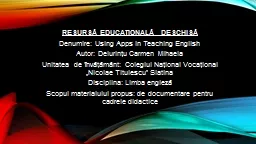PPT-RESURSĂ EDUCAŢIONALĂ DESCHISĂ
Author : tatyana-admore | Published Date : 2018-12-06
Denumire Using Apps in Teaching English Autor Delurințu Carmen Mihaela Unitatea de învăţământ Colegiul Național Vocațional Nicolae Titulescu Slatina
Presentation Embed Code
Download Presentation
Download Presentation The PPT/PDF document "RESURSĂ EDUCAŢIONALĂ DESCHISĂ" is the property of its rightful owner. Permission is granted to download and print the materials on this website for personal, non-commercial use only, and to display it on your personal computer provided you do not modify the materials and that you retain all copyright notices contained in the materials. By downloading content from our website, you accept the terms of this agreement.
RESURSĂ EDUCAŢIONALĂ DESCHISĂ: Transcript
Download Rules Of Document
"RESURSĂ EDUCAŢIONALĂ DESCHISĂ"The content belongs to its owner. You may download and print it for personal use, without modification, and keep all copyright notices. By downloading, you agree to these terms.
Related Documents

